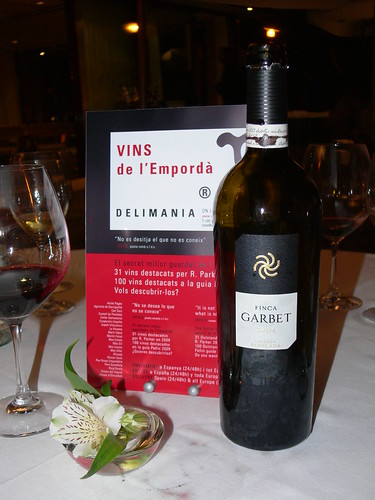Today we’ll talk about the vineyards of Sefarad, on a tour of four Jewish and visit the cellars of fine wines. At this time of year the roads are teeming with vineyards Sefarad. Proudly show off its green lushness, announcement of a bumper crop. It’s the best invitation to a journey that unites the Jewish wine. In place are the cellars where they make some of the best Spanish wines. A nexus that is rooted in history, when Jews taught growers the most advanced art of the vine to the Christian peasants.

Photography by catavinsemporda
Wine route Ribadavia:
This is our first route of wine and nothing better to start Ribadavia where Sephardic traders and processors engaged in the business of wine exported to countries like England, Portugal, France and Holland. No wonder that the most important Galician Jewry is in this town Ourense. His imprint can be found in taverns and bakeries, such as Herminia, in the Puerta Nueva de Arriba, which produces sweet Sephardim. The Jewish quarter is among the main square and the walls, around Porta Nova. In its arcaded streets and narrow passageways, simple and well-preserved houses with overhangs and domestic wineries, time seems stopped.
Ribadavia has among its most renowned wineries in the local cooperative, Wine Ribeiro, one of the largest and most technologically advanced. A must to taste their wines. No less important is the character work so singular and lucid as Emilio Rojo, owner of a vineyard in Ponte Arnoia with which produces a dreamy white, or Javier Alen, pioneer of Viña Mein wine tourism, cellar built with sensitivity and good taste. It is located in a bucolic landscape, surrounded by vineyards, including six double rooms of accommodation.
Wine route in Toledo:
Poets, scientists, translators, philosophers, business, financial and Sephardic Talmud teachers made Toledo the spiritual and cultural center of all Jewish communities of the West. Here was the School of Translators, a paradigm of coexistence between Muslims, Jews and Christians. Its large Jewish occupied the southwest of the capital, to the river Tagus, and included the fortress known as the Castro of the Jews. It has two beautiful synagogues, Christianized as Santa María la Blanca and El Transito.
To scan the city, eat and enjoy a wine estimable, we approached the Cerro del Emperador, where Charles V provided for the capital of his empire. Here is the complex Cigarral Vineyards Santa Maria, owned by Adolfo Munoz. Here good food and fine wines but nothing better than a drink on the terrace, watching the vineyards.
Tarazona wine route:
In Tarazona, the Mudejar brick has become art. Girded by a belt, its core foundation walls, has one of the oldest Jewish communities and best preserved in Spain. It lost by its winding streets, Carrer de Vilanova, stroll along the Rua Alta and Baja in the old Jewish quarter, in awe before the Gate of Zuda, approaching Conde Street to see the hanging houses, discover a typical building in the square of Archdeacons, and a halt to the main synagogue in the Conservative Party.
We are in the Campo de Borja wine region, a land of old and forgotten garnachas bush at the foot of the Moncayo. Mandan cooperatives, but there are also small developers like Peter Aibar. Of its seven hectares of vineyards, are modest but cutting-edge facilities, develops Payments Moncayo, a magnificent red-adjusted price. And if we aspire to excellence, we visit the winery Alto Moncayo, created by Jorge Ordonez and Borsao. Its wine Aquilon is one of the best in the country. That itself is expensive, very expensive.
Wine route in Girona:
Girona is a city of rivers, discussed and disputed, Girona knows fences, sieges and suffering. As the Sephardi community, the most flourishing of Catalonia. In the year 890 settled there the first 25 families from Emporda, land of wine and food. Good winemakers, merchants and skilled craftsmen outstanding contributed to the prosperity of the city, which paid them with equal and peaceful coexistence. Until the year 1448 were cornered intolerance, held in the Call, name given to the Jewish neighborhoods in Catalonia. You have to slow down the pace in one of cobbled streets, as the Carrer Sant Llorenç, climb the steep stairs, patios and porches across to reach the former synagogue, now the seat of Bonastruc ça Porta Centre and Museum of History of the Jews of Catalonia, which houses a magnificent collection of gravestones and tombstones of the Jewish cemetery of Montjuïc. And from the Carrer de la Força, the Via Augusta Roman Lluís Batlle walk, old street of the synagogue, or the Call Major Judaic, at the end of which was the medieval Jewish market.
Here you will find one of the new wines of Emporda, grapes ripened under the influence of the Tramontana, altering minds and vegetative cycles. There are wineries worth a visit. The most important and innovative is Castillo de Peralada. There are two recommended wines Ex EX 7, or Finca Garbet. Then, close to the vineyards of Celler Oliver Conti, in the Alt Emporda. Settle in areas rich in flint that allow the miracle of minerality. And has rooms to stay.
What do you recommend wine routes? Send your suggestions.
Leave a Reply
You must be logged in to post a comment.
Recent Comments